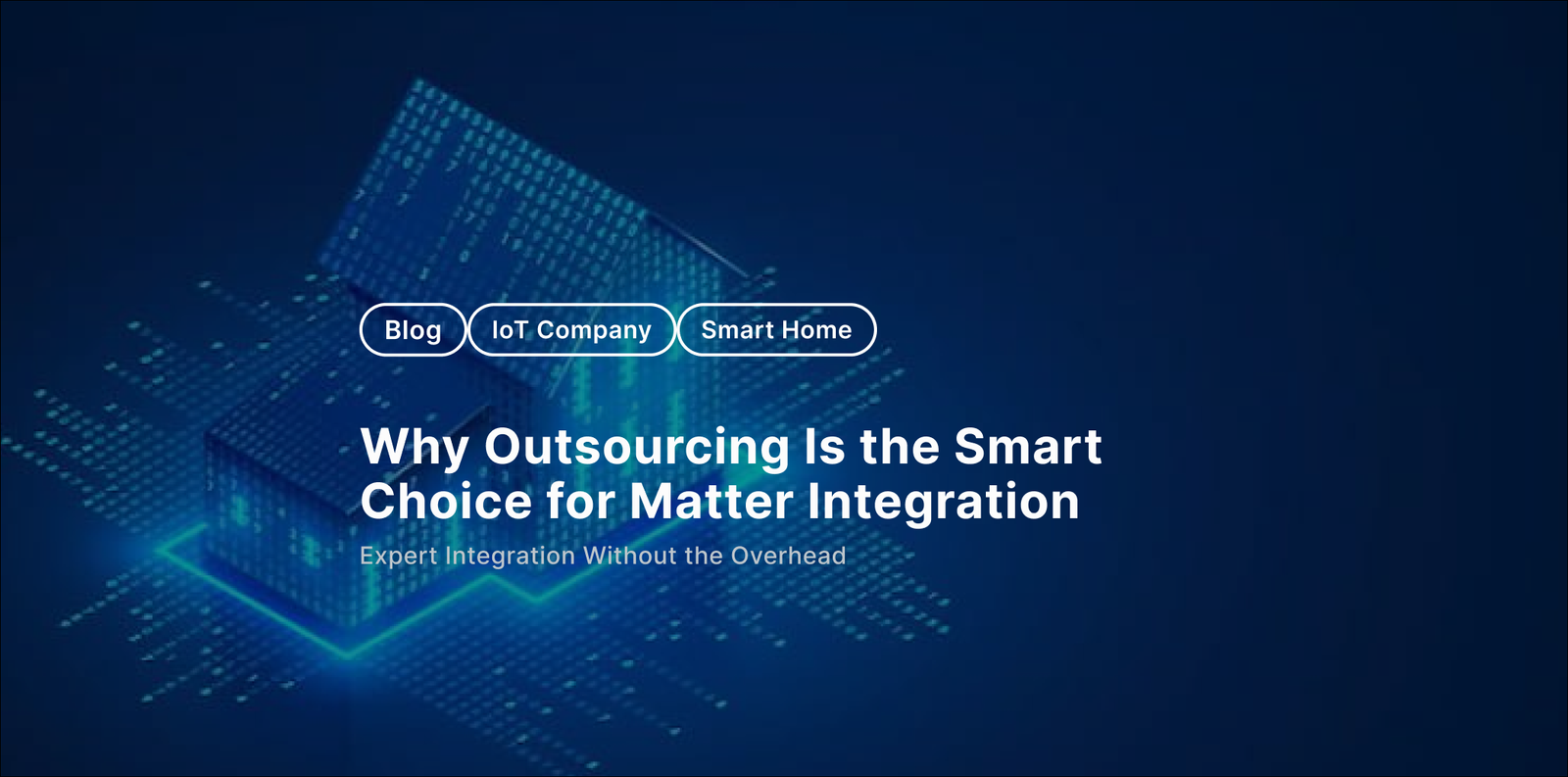✆ + 1-646-235-9076 ⏱ Mon - Fri: 24h/day
Why Outsourcing Is the Smart Choice for Matter Integration


Matter has quickly become the most important standard in the smart home industry. Backed by Apple, Google, Amazon, and Samsung, it promises to solve a problem that has frustrated customers for years: interoperability. Instead of asking “Will this bulb work with my app?”, the promise of Matter is that everything simply works.
For companies building IoT devices, this is both an opportunity and a challenge. The opportunity is access to millions of homes across ecosystems. The challenge is that Matter is a new, highly technical standard that requires expertise in protocols, security, certification, and cloud-to-device integration.
That is why outsourcing Matter development has become the smart choice. Let’s explore why.
What is Matter and Why Does It Matter?
Matter is a connectivity standard introduced in 2022 by the Connectivity Standards Alliance (CSA), a group that includes Apple, Google, Amazon, and Samsung. It is built on existing technologies like Thread, Wi-Fi, Bluetooth Low Energy, and provides a common language for smart home devices.
The goal is simple: if your device supports Matter, it can work across Apple Home, Google Home, Alexa, and SmartThings.
But the implementation is not so simple. Matter requires:
- Secure commissioning processes
- Thread networking and device roles (border router, sleepy node, etc.)
- Device attestation and certification by the CSA
- Integration with mobile apps and hubs
This makes Matter integration a niche skillset, and one where outsourcing can give you a major advantage.
Why Outsourcing Helps with Niche Standards Like Matter
Access to Certified Expertise
Matter certification is mandatory if you want your product to use the logo. Outsourcing partners often already have experience with CSA testing labs, tools like chip-tool, and cloud integration frameworks. They can help you pass on the first attempt, saving months of delays.
Faster Time to Market
Every month you delay, competitors like Ikea, Aqara, or Eve capture more of the market. Training an internal team could take 6–12 months. Outsourcing gives you a team that can start development immediately.
Cost Control and Flexibility
Hiring Matter engineers full time is expensive. Outsourcing lets you scale resources up or down depending on the phase: architecture, firmware development, mobile app integration, or certification.
Reduced Risk
Matter is still evolving. Each release (1.0, 1.1, 1.2, 1.3, 1.4) added new device types and onboarding options. Outsourcing to specialists who track these changes reduces the risk of building on outdated assumptions.
Real-World Examples of Matter Adoption
Ikea: Scaling Smart Homes with Matter
Ikea launched new Matter-enabled lights, sensors, and air monitors in 2024. This was part of a complete shift to Matter and Thread as their foundation for smart homes. They moved quickly because they partnered with experts, not because they retrained every in-house engineer.
Google: Local Control with Matter
Google announced that Matter devices can now be controlled locally on Google Home hubs, even without internet access. This required deep protocol work, cloud-to-local sync, and chip integration. Outsourced collaborations with hardware vendors like MediaTek made it possible.
Samsung and Ikea: Matter Bridge
Samsung SmartThings partnered with Ikea to create a Matter Bridge. This allows even legacy Zigbee devices to show up as Matter devices inside the SmartThings app. This is an example of using Matter not just for new devices, but also to extend value to old ecosystems.
Outsourcing vs In-House: A Comparison
| Criteria | In-House Development | Outsourcing Development |
| Time to Market | 6–12 months training and prototyping | 2–4 months with experienced team |
| Costs | High fixed salaries | Flexible, project-based |
| Certification Success | High risk of failure on first attempt | Higher chance of first-pass success |
| Expertise | Limited, general IoT experience | Specialized Matter engineers |
| Focus | Internal team distracted | Internal team stays on core product |
SEO-friendly Deep Dive: Key Challenges in Matter Development
To better understand why outsourcing works, let’s break down common challenges:
1. Matter Device Commissioning
Secure commissioning is essential. Devices must be paired using QR codes or NFC onboarding. A mistake here creates security vulnerabilities. Outsourced experts already know the flows and testing requirements.
2. Thread Networking
Thread is a mesh protocol optimized for low power. Border router design, sleepy node optimization, and routing are non-trivial. Outsourcing helps avoid common pitfalls like excessive battery drain or poor coverage.
3. Interoperability with Ecosystems
Matter works across Apple Home, Google Home, Alexa, and SmartThings, but each has nuances. Apple enforces stricter HomeKit rules. Google Home requires cloud sync. Outsourcing brings experience across ecosystems.
4. Certification Process
CSA certification involves multiple labs and test harnesses. Outsourcing teams with prior experience can prepare your firmware and documentation correctly.
When Should You Outsource Matter Development?
- You are building your first Matter-enabled product
- You need to pass certification quickly
- Your team lacks Thread or BLE expertise
- You cannot afford long training cycles
- Time to market is critical for investors or customers
The Smart Way Forward
Matter is not just another IoT buzzword. It is the foundation of the future smart home. For companies, it opens doors to millions of households. But it is also a moving target, with complex technical and certification requirements.
Outsourcing Matter development gives you speed, expertise, and peace of mind. Instead of training a team for a year, you can launch a certified, market-ready product in a few months.At Fordewind.io, we help IoT companies build Matter-enabled products from firmware to mobile apps and cloud. If you are planning your Matter integration, let’s talk.